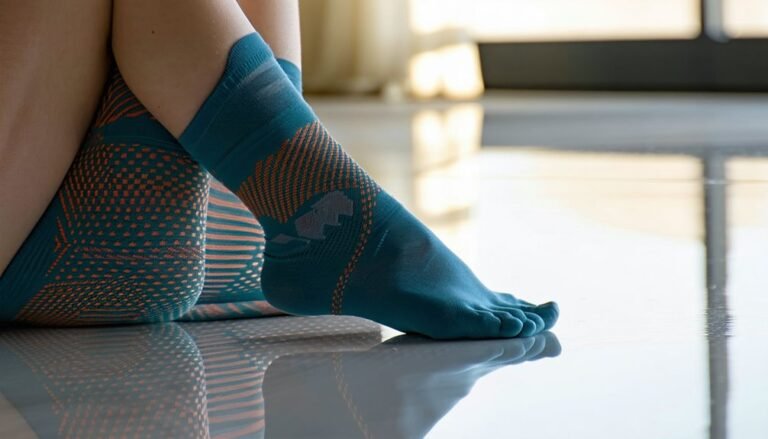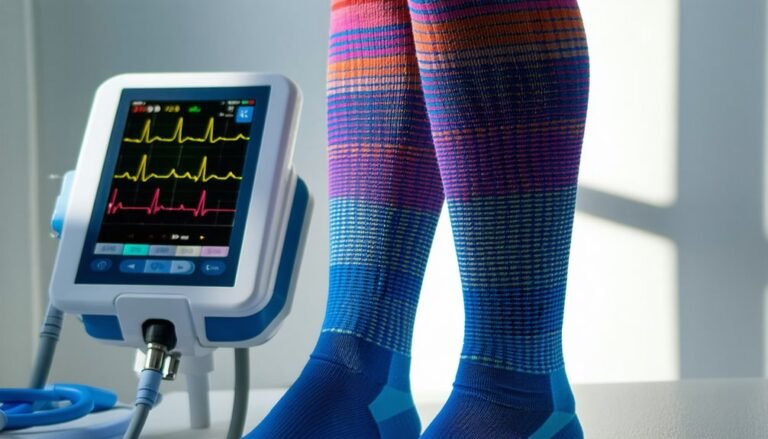How Long Should You Wear Compression Socks
You should wear compression socks for about 6 to 8 hours daily, but this can vary based on your activity level and specific needs. If you're active or sitting for long periods, contemplate wearing them during exercise or while traveling. Always listen to your body; if you experience tightness, pain, or swelling, it's time to remove them. There are many factors to contemplate, so exploring further can help you optimize your sock-wearing strategy.
Understanding Compression Socks and Their Benefits

Compression socks are designed to apply gentle pressure to your legs, which can enhance blood flow and reduce swelling. There are various compression sock types available, including graduated, anti-embolism, and athletic socks, each serving distinct purposes. Graduated socks provide the most compression at the ankle, gradually decreasing up the leg, which is beneficial for preventing vein-related issues. Anti-embolism socks are often used in clinical settings to prevent blood clots during prolonged immobility. Athletic socks help reduce muscle fatigue during exercise. The health benefits of wearing compression socks include improved circulation, reduced leg fatigue, and decreased risk of varicose veins. Properly choosing the right type and fit is essential to maximize these advantages while ensuring safety.
Factors Influencing Duration of Wear
When considering how long to wear compression socks, several factors come into play. Your medical conditions, activity level, and the grade of compression in the socks can all influence the recommended duration. Understanding these elements will help you maximize the benefits of compression therapy.
Medical Conditions Consideration
While various medical conditions can impact your need for compression socks, understanding these influences is essential for effective use. Your specific needs might vary considerably depending on the condition you have. For instance, if you're managing chronic venous insufficiency, longer wear times may be necessary. Conversely, those with mild swelling might only need them during certain activities.
| Medical Condition | Recommended Duration |
|---|---|
| Chronic Venous Insufficiency | 20-24 hours daily |
| Deep Vein Thrombosis | As prescribed by a doctor |
| Lymphedema | 24 hours or as directed |
| Pregnancy | During the day, as needed |
Always consult your healthcare provider for personalized guidance on how long to wear these socks based on your specific needs.
Activity Level Impact
Your activity level plays a significant role in determining how long you should wear compression socks. If you're engaging in high-intensity activities, like running or cycling, you may benefit from wearing them during and after your workout to aid recovery. For those with a sedentary lifestyle, wearing them throughout the day can help prevent swelling and discomfort.
Consider these factors when evaluating wear duration:
- Intensity of Activity: Higher intensity may require longer wear.
- Duration of Activity: Longer sessions might necessitate extended wear times.
- Recovery Needs: Post-activity wear can enhance recovery.
Ultimately, adjust your compression sock wear duration based on your specific activity level to maximize benefits and guarantee safety.
Sock Compression Grade
Understanding the sock compression grade is vital for determining how long you should wear compression socks. Compression levels vary, typically ranging from mild (8-15 mmHg) to graduated (20-30 mmHg) and medical (30-40 mmHg). Higher compression levels provide more support but may require shorter wear durations, especially if you're new to using them.
Sock fit is also important; poorly fitting socks can lead to discomfort or even complications. For best results, confirm the socks fit snugly but don't restrict blood flow. Generally, it's advisable to wear lower compression levels for longer periods, while higher levels may necessitate breaks. Always consult a healthcare professional for personalized recommendations based on your specific needs and conditions.
Recommended Wearing Times for Different Activities
When considering the recommended wearing times for compression socks, it's essential to tailor usage to specific activities for maximum benefits. For running sessions, it's best to wear them during the activity and for a couple of hours afterward to aid recovery. In daily routines, you can wear compression socks for extended periods, typically up to 12 hours, especially if you're on your feet frequently.
- For long flights, wear them during the entire trip to prevent swelling.
- If you're sitting for long hours at work, put them on to improve circulation.
- Post-surgery or injury recovery? Use them as advised by your healthcare provider for ideal healing.
Tailoring your usage guarantees safety and effectiveness.
Compression Socks for Athletes: Best Practices

Compression socks have become an essential tool for athletes aiming to enhance performance and recovery. When using compression socks, it's important to select the right level of compression depending on your activity—typically between 15-30 mmHg for most athletes. Wearing them during workouts can improve blood circulation, reduce muscle vibration, and decrease fatigue. Post-exercise, wearing compression socks can be a crucial part of your recovery strategies, helping to minimize soreness and speed up recovery time. Be sure to wear them for 1-2 hours post-activity for ideal benefits. Always listen to your body; if you experience discomfort, remove them immediately. Incorporating compression socks into your routine can greatly contribute to your overall performance enhancement and recovery.
Guidelines for Post-Surgery Recovery
After intense physical activity, recovery becomes even more important, especially following surgery. Adhering to post surgery guidelines can greatly enhance your recovery timeline. Wearing compression socks is one effective method to promote circulation and reduce swelling.
- Follow your surgeon's recommendations on when to start wearing compression socks.
- Typically, you'll want to wear them for at least two weeks post-surgery.
- Monitor your legs for any signs of discomfort or unusual swelling.
Wearing Compression Socks During Travel
Traveling for extended periods, especially by plane or car, can increase your risk of developing blood clots and experiencing leg swelling. Wearing compression socks during travel offers significant travel benefits by promoting better blood circulation in your legs. This is particularly important during long journeys, where immobility can lead to discomfort and potential health risks.
Choosing the right level of compression is key; it should be firm yet comfortable to guarantee you can wear them for hours without irritation. Look for designs that provide a snug fit without restricting movement. By prioritizing sock comfort, you can effectively reduce the risk of complications, providing a more pleasant travel experience. Always remember to put on your compression socks before your journey begins for ideal protection.
Signs of Discomfort and When to Remove Them

When wearing compression socks, it's essential to recognize signs of discomfort, such as tightness, pain, or tingling in your legs. If you experience these symptoms, you should consider removing the socks to prevent potential complications. Knowing the recommended timing for removal can help guarantee peak comfort and effectiveness.
Common Discomfort Symptoms
Although compression socks are designed to improve circulation and reduce swelling, it's vital to recognize signs of discomfort that may indicate they're not fitting properly or are being worn for too long. If you experience any of the following symptoms, it's important to assess your sock fit and consider removing them:
- Numbness or tingling in the feet or legs
- Visible marks or indentations on the skin
- Increased swelling or pain, indicating potential circulation issues
These symptoms suggest that your compression socks might be too tight or causing adverse effects. Always prioritize your comfort and safety; if discomfort persists, consult a healthcare professional to verify you're using the right size and level of compression for your needs.
Recommended Removal Timing
While wearing compression socks can be beneficial, knowing when to remove them is vital for your comfort and health. Adhering to removal guidelines is important, especially if you experience any discomfort, swelling, or changes in skin color. If you notice tightness, pain, or tingling, it's time to take them off. Generally, the ideal duration for wearing these socks is between 6 to 8 hours daily, but this can vary based on activity level and personal needs. Always listen to your body; if you feel any adverse effects, don't hesitate to remove them. Regularly evaluating your comfort will guarantee that compression socks serve their purpose without compromising your well-being. Prioritize your safety by monitoring how your legs respond.
Tips for Choosing the Right Compression Sock Duration
Choosing the right duration for wearing compression socks can greatly impact their effectiveness. To guarantee you're optimizing their benefits, consider the following tips:
- Understand compression sock types: Different sock types are designed for varying purposes, such as daily wear or post-exercise recovery.
- Follow sock fit recommendations: Proper fit is essential; make sure your socks are snug but not overly tight to avoid circulation issues.
- Monitor your body's response: Pay attention to how your legs feel while wearing them; if you experience discomfort, adjust the duration accordingly.
Frequently Asked Questions
Can I Sleep With Compression Socks On?
Imagine floating on clouds as you sleep! Yes, you can wear compression socks at night. They enhance circulation, providing sleep benefits like reduced swelling and improved blood flow, ensuring your legs feel rejuvenated when you wake up.
Are There Any Side Effects of Wearing Compression Socks?
Yes, there can be side effects from wearing compression socks, like skin irritation or numbness. If you have underlying health concerns, it's essential to consult a healthcare professional before using them regularly. Safety first!
How Do I Know if My Compression Socks Fit Correctly?
Finding the right fit for compression socks is like choosing the perfect pair of shoes. Use a size guide for fit assessment, ensuring the socks aren't too tight or loose, promoting safety and comfort throughout your day.
Can I Wash Compression Socks in a Washing Machine?
Yes, you can wash compression socks in a washing machine, but use gentle washing techniques. Avoid hot water and harsh detergents to guarantee sock longevity and maintain their compression effectiveness. Always follow the manufacturer's care instructions.
Are Compression Socks Suitable for Everyone?
You might think compression socks are for everyone, but not quite. Certain medical conditions and age considerations can make them unsuitable. Always consult a healthcare professional to guarantee they're safe and effective for your situation.







